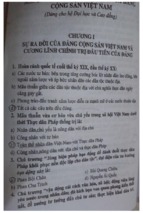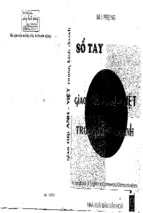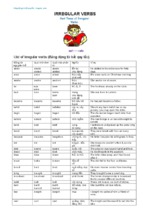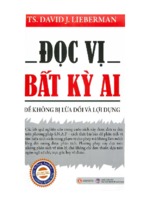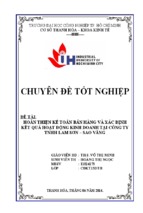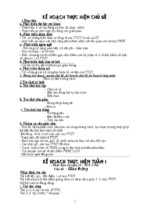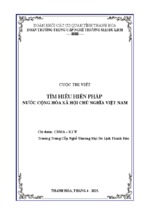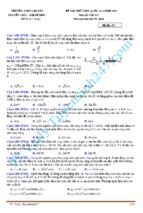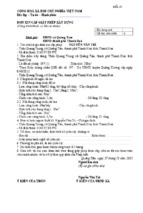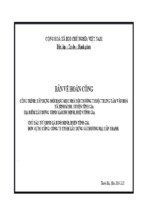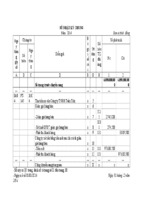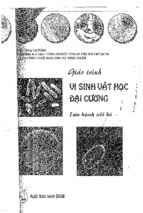2019 – 20201 (2)
ENGLISH LANGUAGE
MINISTRY OF EDUCATION AND TRAINING
HANOI OPEN UNIVERSITY
M.A.THESIS
A CONTRASTIVE ANALYSIS ON STREET NAMES IN
LONDON AND HANOI
( Đối chiếu tên đường phố ở Luân Đôn và Hà Nội)
HOÀNG TRUNG NGHĨA
HOÀNG TRUNG NGHĨA
Field: English Language
Code: 8.22.02.01
HANOI - 2021
MINISTRY OF EDUCATION AND TRAINING
HANOI OPEN UNIVERSITY
M.A.THESIS
A CONTRASTIVE ANALYSIS ON STREET NAMES IN
LONDON AND HANOI
( Đối chiếu tên đường phố ở Luân Đôn và Hà Nội)
HOÀNG TRUNG NGHĨA
Field: English Language
Code: 8.22.02.01
Supervisor: LÊ THỊ MINH THẢO Ph.D
HANOI - 2021
CERTIFICATE OF ORIGINALITY
I, the undersigned, hereby certify my authority of the study project report entitled “A
Contrastive Analysis on Street names in London and Hanoi” submitted in partial
fulfillment of the requirements for the degree of Master in English Language. Except where
the reference is indicated, no other person’s work has been used without due
acknowledgement in the text of the thesis.
Hanoi, 2021
Hoàng Trung Nghĩa
Approved by
SUPERVISOR
Date: ……………………
i
ACKNOWLEDGEMENTS
It has been a long journey for me to finish my thesis. There are also many people
who walked along with me to support and motivate me during the time of doing the
research.
First and foremost, I would like to express my sincere gratitude to Ms.Le Thi Minh
Thao, Ph.D my supervisor, who has patiently and constantly supported me through the
stages of the study, and whose stimulating ideas, expertise, and suggestions have inspired
me greatly through my growth as an academic researcher.
My thanks also go to all my lecturers at Hanoi Open University for their precious
knowledge which lay the foundation for this study, my colleagues and many others whose
support and encouragement help me to have this thesis accomplished.
Last but not least, I am greatly indebted to my family and friends for their patience,
endless love, and devotion. Whatever choices I have made, they have always stood by me
and believed in me. I am immensely thankful for all the assistance they have given to me.
ii
ABSTRACT
Research on place names, especially street names, is always an attractive topic for
many researchers. Taking the street names of two districts and one area in London and
three urban districts of Hanoi as the object of the survey, the thesis has approached and
learned about the street names in the cities centre of London and Hanoi, in the present
context that there are rare research on place names from a linguistic perspective on a certain
area of Hanoi capital. In this thesis, we study street names in London and street names in
Hanoi to find out their structural features and semantic features of the street names of both
London and Hanoi. The methods used in this study include: Research approach, Data
collection, Data analysis .The thesis studies place names as a complete lexical unit
(word/phrase), belonging to the lexical vocabulary in language. Place names have the
function of naming specific things that exist on the earth's surface, taking on geographical
space, helping to distinguish one thing from another. However, the perception of each
ethnic group is different, therefore, the place names also have different interpretations and
expressions (phonetic shell). The important thing when learning a place name is a matter
of its meaning or reason for naming it. This is due to the change in the internal structure of
the language and also the influencing factors of the external environment, what we call
"compose structure" and "identification method. The comparative comparison between the
two street names of the two capitals is to find out the similarities and differences between
the street names of the two countries, thereby contributing to the increase of research
literature on said street names particular and the place names in general.
iii
LIST OF TABLES
Table 2.1. The position of place names in the overall relationship with other
specialties of linguistics ……………………………………..………….19
Table 3.1. Structural model of street names …………………….……… 23
Table 3.2. The complex structure of street names………………..……….25
Table 3.3. Statistics of street names by types of structure………..……….27
Table 3.4. Street names base on some criterias…………………..………34
Table 3.5 Structural model of street names…………………….………35
Table 3.6. Statistics of places by number of elements………….……….37
Table 3.7. Street name has a simple structure according to the criteria from
a single syllable structure and the name of a polysyllabic person belongs to
single structure……………………………………………..……………38
Table 3.8. Street names base on some criterias………………………….48
iv
TABLE OF CONTENTS
CERTIFICATE OF ORIGINALITY .........................................................................i
ACKNOWLEDGEMENTS ..................................................................................... ii
ABSTRACT ............................................................................................................ iii
LIST OF TABLES ...................................................................................................iv
Chapter 1 ...................................................................................................................1
INTRODUCTION ....................................................................................................1
1.1 Rationale ............................................................................................................. 1
1.2. Aim and objectives: ........................................................................................... 2
1.2.1. Aim of the study: ............................................................................................ 2
1.2.2. Objectives of the study: ..................................................................................2
1.3. Scope of the study ..............................................................................................2
1.4. Research questions ...........................................................................................2
1.5. Methods of the study ..........................................................................................2
1.6. Significance of the research ............................................................................... 5
1.7. Structure of Thesis ............................................................................................. 6
Chapter 2 LITERATURE REVIEW……………………………………………….7
2.1. Review of previous studies ................................................................................7
2.1.1. Previous studies of foreign Linguists ..............................................................7
2.2.2. Previous studies of Vietnamese Linguists ....................................................10
2.2.2.1 Study on places in Vietnam. .......................................................................10
2.2.2.2. Study on street names in Hanoi .................................................................12
2.3. Review of theoretical background ................................................................... 13
2.3.1. Concept of place-name .................................................................................13
2.3.2 Place-name classification ...............................................................................15
2.3.3 The function of place names ..........................................................................18
2.3.4. Some theoretical problems about proper names ...........................................21
2.4. Summary ..........................................................................................................21
Chapter 3 ................................................................................................................. 23
COMPARISION BETWEEN STREET NAMES LONDON AND HANOI ......... 23
v
3.1. The features of language of street name in London.........................................23
3.1.1. Structural features. ........................................................................................23
3.1.2. Semantic features ..........................................................................................27
3.1.2.1. Street names describe colour .....................................................................27
Street names that describe colors account for only 2.2 % ......................................27
For example: Orange street, Green street… ...........................................................27
3.1.2.2. Street names reflect the direction and position of objects relative to other
objects .....................................................................................................................28
3.1.2.3. The streets are named after the Abbot, bishop, Dean’s name. ..................28
3.1.2.4. Street names are named after people's wishes ...........................................29
3.1.2.5. The streets are named after the famous people, history character .............29
3.1.2.6. Street names are named after local landowners .........................................30
3.1.2.7. Street names are named after other groups ................................................31
3.2. The features of language of street name in Hanoi ...........................................35
3.2.1. Structural features .........................................................................................35
3.2.2. Semetic features ............................................................................................41
3.3. The similarities and differences between the street names in London and Hanoi
................................................................................................................................. 48
3.3.1. Similarities .................................................................................................... 48
3.3.2. Differences .................................................................................................... 49
3.4. Implication ....................................................................................................... 51
3.5 Summary ........................................................................................................... 52
Chapter 4 ................................................................................................................. 53
CONCLUSION ....................................................................................................... 53
4.1. Recapitulation of the study .............................................................................. 53
4.2. Concluding remarks ......................................................................................... 54
4.3.Limitation of the research ................................................................................. 55
4.4. Recommendation/ Suggestion for further research ......................................... 55
REFERRENCES ..................................................................................................... 56
vi
Chapter 1
INTRODUCTION
1.1 Rationale
In the world, everywhere around us, everything and phenomenon has a name. The
strange thing is the name appears as soon as people recognize and understand them.
It can be people's names, river names, mountain names, village names,
neighborhood names, street names, tools names, etc. Those names arise from the
actual needs of people. Humans need to have a clear distinction between things, this
object with things, that object, between this space and another space. Although, that
name may be different from region to region and piece of land, at least they are
"used" and "reused" by the community there for a long time. It has a very strong
vitality. Maybe the thing, the phenomenon has disappeared, but its name is still and
is remembered. Those names are proper names, the study of which has formed a
separate discipline called onomasiologie. If the object of study of onomasiologie is
a person's name, it is called name, and if the object of study is names associated with
geographical space, it is toponymy.
The study of place names plays an important role in linguistics, especially in the
study of language history. In terms of internal structure, it has a significant impact
and influence on finding the rules of language structure. Place name is a fairly fixed
and long-lasting vocabulary, so investigating and studying it will give us more
accurate conclusions than using other words. Moreover, the basic function of place
names is to identify and personalize objects, so they can exist in the present time
even when the object no longer exists or has lost its meaning. Many people use place
names just to call name or distinguish one object from another without fully
understanding its meaning.
The study of place names in general and the study of street and street names in
general not only clarify the rules and ways of language structure, but also clarify the
culture, history, traditions... each region. Street names have a close relationship with
the culture and history where they were formed. Each name, each place that appears
has its own reasons and interpretations of the people there. Moreover, they can have
many different names, associated with different events. Those place names help us
to go back in time, learn about the cultural features and changes of the nation's
history. It is a mirror that reflects the contemporary and historical values of language
1
and culture. Obviously, the study of street names is closely related to the study of
culture and history, which is an urgent issue in the current period.
The study of street names in some districts of london and hanoi is not only
meaningful a region but also meaningful for the capitals of two countries.
Contributing to a deep understanding of the history and culture of london and hanoi.
This is the reason why we have chosen the topic " A constractive anlaysis on street
name in London and Hanoi" as our master's thesis.
1.2. Aim and objectives:
1.2.1. Aim of the study:
This thesis sets out the purpose of comparing street names in London and Hanoi in
order to point out the structural and semantic features of the naming method of street
names in the two cities above from a linguistic perspective.
1.2.2. Objectives of the study:
- Finding out the structural and semantic features of street-names in London and
Hanoi
- Investigating the similarities and differences between street-names in London and
Hanoi.
- Suggesting the implication of the thesis.
1.3. Scope of the study
The scope of research of the thesis is street-names in the whole districts in London
and Hanoi in current period. However, the number of street-names is too large, We
only research some streets in three districts of London are Marlybone, Westminster
and Soho area and Hanoi is Ba Dinh, Hoan Kiem, Hai Ba Trung district.
1.4. Research questions
1. What are the structural features of street-names in London and Hanoi ?
2. What are semantic features of street-names in London and Hanoi ?
3. What are the similarities and differences of language of street-name in London
and Hanoi ?
1.5. Methods of the study
The methods used in this study include:
Research approach:
The mixed method (quantitative method and qualitative method) and contrastive
method is based on the foundation below in applying in this dissertation:
(i)
Quantitative approach
2
As the primary example of hypothesis-testing research, quantitative method begins
with a question or hypothesis to be investigated through data quantification and
numerical analyses. Quantitative approaches revolve ‘how much, how often or how
many’ (Judd et al,1991, p.174) or this is the label for ‘numerical research’ (Brown
& Rodgers, 2002: 15). Including key elements like formal and systematic
measurement and the use of statistics, studies that make use of statistical analyses
to obtain their findings are involved in quantitative method. The researcher does not
necessarily presuppose a realist or objectivist point of view; rather, the researcher
can presuppose the categories or entities that he/she operationalizes to be socially
and cognitively constructed (Ender, 2012:198).The potential weaknesses of
quantitative research include great attention paid to the technical details of the
research in general, and to measuring techniques and procedures in particular; too
much respect to numerical data, which are produced intentionally but interpreted as
objective phenomena (McMillan & Schumacher, 1993; Jonker & Pennink, 2010).
Data can be analyzed using statistical methods or particular mathematics tools
allowing us to work with numerical data (Lia, 2010: 52).SPSS statistics - a software
package used for interactive or batched statistical analysis - is a widely used program
for statistical analysis in social science. Being appropriate for people with little
experience in statistics and programming because of its user-friendly interactive
features, the original SPSS manual (Nie, Bent & Hull: 1970) has been described as
one of ‘sociology's most influential books’ for allowing ordinary researchers to do
their own statistical analysis.
(ii) Qualitative approach
Qualitative approach is chosen to analyze linguistic data because of the provision of
a thick description and analysis of a specific program, practice or setting (McMillan
& Schumacher, 1993). The ultimate goal is to discover phenomena not previously
described and to understand them from the perspective of participants in the activity.
Multiple perspectives of reality are crucial to an understanding of why people think
and act in the different ways they do, particularly, the essentially main measurement
devices (own values, personal history and position on characteristics (gender,
3
culture, class, and age)) in one study have become an integral part of the inquiry in
order to interpret phenomena in terms of the meanings people attach to them. This
fundamentally interpretive method affirms that the research outcome is ultimately
the product of the researcher’s subjective interpretation of the data. Once all the data
are collected, hypothesis may be derived from those data; in other words, research
that places primary importance on studying small samples of purposely chosen
individuals should be applied with qualitative method. ‘Open-ended explorations of
people’s words, thoughts, actions, and intentions’ as a means of obtaining
information are involved in qualitative research (Judd, et al., 1991: 299). Qualitative
research does not attempt to control contextual factors but rather seeks, through a
variety of methods, to understand issues from the informants’ points of view in order
to create a rich, holistic and in-depth picture of the phenomena under investigation.
The advantages included are the facilitation of ‘study of issues in depth and detail’
and the production of ‘a wealth of detailed information’ (Patton, 2002: 14) as well
as some weaknesses as a bad distinction between facts and interpretation, a low
repeatability of research approach, the impossibility of precisely describing results
in advance, the explicit acknowledgement of the researcher’s subjectivity and a
reduction in generalizability and so on (McMillan & Schumacher, 1993; Patton
2002; Jonker & Pennink, 2010).
(iii) Contrastive approach
‘Contrastive linguistics is the systemic comparison of two or more languages, with
the aim of describing their similarities and differences’ (Johansson & Hoffland
(1994: 25-37); in which, ‘The comparative method by comparing particular
phenomena in several related (or presumably related) languages’ (Bussmann,1996:
398).Contrastive approach, implying ‘more interested in differences between
languages than their likeliness’ (James, 1980: 2-3), is defined as the ‘sub-discipline
of linguistics concerned with the comparison of two or more languages or
subsystems of languages in order to determine both the differences and similarities
between them’ (Fisiak,1981:1). In this dissertation, contrastive analysis is
4
considered as ‘a linguistic enterprise aimed at producing inverted (i.e., contrastive,
not comparative) two-valued typologies… and founded on the assumption that
languages can be compared’ (James, 1980: 03).
In order to achieve the aim, this study use of both qualitative and quantitative
research design employing descriptive and contrastive analysis method. Qualitative
methods include contrastive analysis and description. Descriptive method is used in
the study to provide description meaning of street-names in London and Hanoi.
Data collection:
In this study, the researcher uses documentary technique in collecting data.
The data sources of the study are street names of in three districts of London are
Marlybone, Westminster and Soho area and Hanoi is Ba Dinh, Hoan Kiem, Hai Ba
Trung district.
Data analysis:
Data collected will be mainly analyzed on the basis of the following points:
Semantic features: the classification is carried out on the basis of typical sematic
features street-names in London and Hanoi. For instance: Streets are named after
specialized occupation, Streets are named after famous people, etc…
Structural features: the classification is carried out on the basis of typical different
structures namely: Street names have complex structure, street names have a
complex structure according to the main-sub relationship, street names have
complex structure according to coordinated relation, etc...
1.6. Significance of the research
The study of place names in general and street names in particular, plays an
important role in linguistics, especially in the study of language history. In terms of
internal structure, it has a significant impact and influence on finding the rules of
language structure. Place name is a fairly fixed and long-lasting vocabulary,
therefore investigating and studying it will give us more accurate conclusions than
using other words. Moreover, the basic function of place names is to identify and
personalize objects, so they can exist in the present time even when the object no
longer exists or has lost its meaning. Sometimes, people use place names just to
name or distinguish one object from another without fully understanding its
meaning.
The study of street names not only elucidates the rules and ways of language
structure, but also clarifies the culture, history, tradition... of each region. Street
5
names have a close relationship with the culture and history where they were
formed. Each name, each place that appears has its own reasons, its own
interpretations of the people there. Moreover, they can have many different names
which is associated with different events. Different names for the same object is an
interesting point of the study of place names. Those place names help us to go back
time, learn about the cultural features and changes of the nation's history. It is a
mirror that reflects the synchronic and epochal values of language and culture.
Obviously, the study of place names is related to the study of regional and regional
cultures - an urgent issue being raised today.
1.7. Structure of Thesis
The thesis consists of 4 chapters as follow:
Chapter 1 is the Introduction of the study which shows the reasons why the
topic is chosen, what the research aims at as well as the scope, the structural
organization of the study.
Chapter 2 is the Literature review and Theoretical background of the study.
This chapter will give the brief review of related literature and theoretical
background of every matter mentioned in the study.
Chapter 3 is Comparison. It presents and analyzes the collected data from
questionnaires as well as gives the similarities and differences of between street
names in London and Hanoi .
Chapter 4 is the Conclusion of the study which presents the recapitulation of
the study, the limitations of the study and some suggestions for further study.
6
Chapter 2
LITERATURE REVIEW
2.1. Review of previous studies
The theoretical knowledge of the study is based on the viewpoint from different
prospects of great linguists as well as the ideas extracted from the researches
previously done. Based on these studies, the author can find out many good ideas
for this thesis. They are foundation for this thesis.
2.1.1. Previous studies of foreign Linguists
George R. Steward argued that “in the beginning, the lands stretched out without a
name.... Then men came and gave them names" [quoted 1, p.4). of place names is
used to orient, or in other words, to distinguish geographical entities from each
other, so it can be understood that place names are born whenever a community
needs to identify a geographical object. In order to keep them from going astray, so
a community's most primitive landmarks with a distinct voice are associated with
their first settlements or living spaces. "The simpler a name (proving) the place (with
that name) the more ancient it is" [1,p.5]. According to the chronological dimension,
Le Trung Hoa believed that history which studies places in the world can be divided
into three stages: embryonic stage, formation stage and development stage [19, p.2224] Meanwhile, based on the research content of topographers, Maoz Azaryahu
believed that the study of places has focused too long on the two stages of
description and classification, and now place research has turned to the analysis of
the political factors of the identity and the cultural product of the location. Through
researches related to place names in the world, it can be seen that there are two main
research trends: research focusing on the description and classification of street
place and research focusing on street palce. The relationship between street places
and socio-political factors. The first direction focuses on the street landmarks
themselves and their relationships with each other while the second focuses on
factors outside the landmark that have a direct influence on the identification
process. However, there may be another classification for studies of place names
abroad. Below, we will in turn review foreign studies on street palces in France and
Europe, in the US and in Asian countries. The issue of street names in urban areas
in France has attracted the attention of many researchers in France. One of the early
7
authors who has in-depth research was Daniel Milo. Milo's article The name of the
street (Les noms des rues) is published in the collection Les Lieux des mémories
edited by Pierre Nora. This anthology is the result of a conference chaired by Nora
from 1978 to 1981. The main content of the anthology revolves around the issue of
memory (mémories) and history (history). The anthology is divided into three
sections including Republic, Country and French Countries and Milo's article is in
the Country section. At the beginning of the article, Milo thinks that studying street
names is an "interesting" topic, but Milo also raises questions about the purpose of
this research as follows: "If you still want to brush up more, even dig In order to
deepen the existing research, one question must arise: what is the point of studying
street names, where are they important? In short, are they a "good topic" for the
historian ?. Classfication which based on the urban areas taken by the researchers
as the case study. To be inherited Milo's research on street names in France, in 1998,
Jean-Claude Bouvier and Jean-Marie Guillon published an anthology on urban
landmarks titled La toponymie urbaine Significations et enjeux (Urban palces):
Meaning and problems). In this collection, the articles mention many issues relating
to urban places and street places such as the origin of urban place the issue of place
and space, the problem of memory and history, issues of place and identity, etc. If
Milo researches on street place in Paris according to the chronological dimension
(with comparison with some local cities in France), the author group including some
researchers from a number of universities in Europe has developed so as to conduct
research on street place in eight cities in different countries located in central Europe
including Graz, Kraków, Olomouc, Prague, Maribor, Zagreb, Zadar, and Mosta. The
research team chose three time points to conduct the research: 1935 (the time before
the 2nd world war and before the outbreak of the socialist revolution in Eastern
Europe), 1985 (the time after the outbreak of the socialist revolution in Eastern
Europe) socialist period, and (which is the present time). The research team
classified the street names of eight cities into five major categories, including:
names of persons, geographical features (geography), names associated with
historical events, and agencies, office (historical events, institution), names
associated with crafts, commerce (crafts and trades), and other groups (others). Each
category is divided into many different groups. The nominal category is divided into
the most groups (5 groups), and the geographical feature category is divided into 4
groups. Other categories are equivalent to a general group. The research results of
8
the authors show that urban places, especially street names are the clearest reflection
of the context and identity of contemporary society. The authors also assert that the
new naming or re-naming of streets and other urban structures is a way of the
contemporary government asserting its position of power, asserting its idea of a the
society they are aiming for. The abolition of the urban name system by previous
administrations was also a way of asserting power. However, the abolition of the
old naming system did not take place at the same time and was completely the same
between cities where the rate of name change was completely different.
*) Research on street place according to descriptive and sampling trends in the US.
The first studies on street place in the US began to appear in the late 19th century
and the early 20th century, the number of research papers increased significantly.
Some of the researches on street places which were born early in the US can be
mentioned here, such as the article Some Principles of Nomenclature by author W.J.
McGee published in the American Anthropologist in 1895. Two years later,
Alexander B. Hagner gave a very important speech before the Congress of the
United States titled Street Nomenclature of Washington City. The speech was later
published in the Records of the Columbia Historical Society, Washington, D.C.
No.7 of 1904. In the following two articles, a 25-page speech by Mr. Justice
Alexander B. Hagner played an important role in naming streets in America. In
essence, this statement is a proposal for a Washington city plan that focuses on
giving street name options in this city. One of the American topographers with many
valuable works with a high citation coefficient is George R. Steward. In his famous
work Name in the Land, George R. Steward divides street names into two groups
"to please pragmatic Americans, numbers and letters are preferred; names
expressing satisfaction are preferred patriotism, honor national and local
achievements, and show love for the homeland and the locality" [According to 9,
pp.77-90]. The analysis and description results of George Stewart (1967) on street
names in the cities of Philadelphia, Washington, New York and Boston show that
the main method of naming streets in these four cities is to use the numbering system
and trial numbers in certain distributions.
*) Research on street places in China and some Asian countries.
In 2002, Li Huajun (FH) analyzed street names in some cities in China based on the
Atlas of 1973 and 1979 in his master's thesis A Preliminary Study on Political Street
Names in China and in 2005. 2011, Shen Yiru mentioned street names in Nanjing
9
in his master's thesis A Lingguistic and Cultural Analysis of Nanjing Street Names.
Most recently, Jonathan Hassid, a postdoctoral scholar at the Institute of Chinese
Studies at the University of Technology Sydney, Australia, mentioned the issue of
street landmarks in Sydney, Australia, referring to the issue of place name streets in
China in the article Place Names, Symbolic Power and the Chinese State. In 1992,
Brenda published the article Street names in colonial Singapore in the journal
Geographical Review. In this paper, Brenda conducted a comparative study of two
street name systems in Singapore, the official street name system issued by the
British colonial government and the street name system named by the Chinese
community. One of Brenda's other typical works is the monograph Toponymics: A
study of Singaporean Street names. In this work, Brenda divided Singapore places
into 7 subcategories including: 1) Colonial place 2) Places named after Asians; 3)
Sites appropriate to different racial groups or multi-ethnic communities; 4)
Descriptive places; 5) Malayized place names; 6) Place names bearing numbers; 7)
Places associated with a special "themed". It can be said that Brenda's classification
is based on criteria such as criteria of origin of place names (origin from England,
Malay origin, Asian origin, etc.
2.2.2. Previous studies of Vietnamese Linguists
2.2.2.1 Study on places in Vietnam.
The chronicle works, history of literature, geography books appearing a lot of
centuries ago may be considered as the first toponymy works in our country. We
may tell the name of typical works in this genre such as: Vietnamese historical
summary, Vietnam Records of the Historian (Ngo Si Lien ), General history
summary of Vietnam, An Nam miscellaneous literary works, Geography book (
Nguyen Trai ), Lich trieu hien chuong loại chi ( Phan Huy Chu ).... From the middle
of the 20th century, some works researched place-names in the angle of language or
place-name approach in interdisciplinary science type, bring the Toponymy of
Vietnam into a real science subject.
We may quote the typical works as follows:
- “ Relation of ancient language in Southeast Asia through some names of river
"(1967) by Hoang Thi Chau.
- "Changes in administrative geography in the French domination period " (1972)
by Vu Van Tinh
10
- “ Method of applying toponymy in research of geography, ancient history of
Vietnam” ( 1984 ) by Dinh Van Nhat
-“ Test discussion about Vietnam place-names ” (1976) by Tran Thanh Tam
The study of place names in Vietnam was born later than in Western countries. At
first, these were purely listing and explanatory products, not paying attention to the
essential issues of toponymy. Most of them are historical and geographical books,
such as: "Geopraphy book" by Nguyen Trai (1380 - 1442), "Complete Annals of
Dai Viet" by Ngo Si Lien (15th century).
Entering the twentieth century, when the study of place names in the world was
developing, in Vietnam, in-depth theoretical studies had just begun to form. It is
advantageous that the topographers in Vietnam have inherited the results, methods
and theories of the world's research, creating momentum for the research of place
names in the country. The leaders in this work are some authors such as: Dao Duy
Anh, Hoang Thi Chau, Pham Duc Duong, Le Trung Hoa, Tran Tri Doi... followed
by: Nguyen Kien Truong, Tu Thu Mai, Tran Van Dung... The works of these authors
which have a great influence on the study of place names in the country, have high
theoretical value, and apply the comparative historical method in the study of place
names. Thanks to that, some issues about place names have been clarified and used
by many fields.
Referring to the above-mentioned domestic research works, first of all, we can
mention a research article by Hoang Thi Chau written in 1964 "Relations of ancient
languages in Southeast Asia through some river names". In this work, Hoang Thi
Chau used linguistic methods to survey the object. This is a new step. Then there
are two associate doctoral theses "Main features of place-name in Ho Chi Minh
City" (1990) by Le Trung Hoa "Main features of Hai Phong place-name by Nguyen
Kien Truong. These two theses both study place names from a linguistic point of
view, taking quite typical survey subjects: one is the southern region, the other is
the northern area. Those were the first monographs on Vietnamese place name in a
specific area. In recent years, two doctoral theses on place name have been
protected, namely "Research on places in Quang Tri " by Tu Thu Mai in 2003 and
"Main features of place names in Dak Lak" by Tran Van Dung in 2003.
Besides, a number of reference books have been published such as "The Handbook
of Vietnamese Places" by Dinh Xuan Vinh (1995), "The Handbook of Vietnamese
Places" by Nguyen Duoc - Trung Hai (1998), " Encyclopedia of Hai Phong places"
11
edited by Ngo Dang Loi (1998), "Dictionary of Hanoi places and places" by Bui
Thiet (1993), or some regional geographies such as "Geography of Nam Dinh"
(2004). ), "Geography of Co Loa" (2007)...
These works tend to collect documents but lack the theoretical nature, so they are
not real place research works.
2.2.2.2. Study on street names in Hanoi
It can be said that up to now, although in Vietnam there have been many works on
collecting and dictionaries of street names in some urban areas in the country, there
has not been any in-depth research on street names in general and Hanoi street
names in particular as the main research object. In the studies of previous scholars,
some authors have only devoted a certain amount of their research to discussing
street names as a subtype of place names in topography in general. Contrary to the
absence of in-depth research on street names, the dictionaries and collections of
street names, especially the streets of Hanoi, were born quite early and have similar
numbers, relatively large. First of all, there are some initial works focusing on
explaining the historical origin of street names such as the work Biography of the
names of Hanoi streets by Thi Nham Dinh Gia Thuyet compiled in 1951 or Ha Noi's
work. The internal guide was compiled by Nguyen Ba Chinh in 1923. In recent
times, the compilation of "biography" of streets in cities throughout the country has
grown relatively strongly through the introduction of a series of street place-name
dictionaries. From a research perspective, from our point of view, Nguyen Van
Uan's article About the street names in Hanoi, first printed in “Nguoi Hanoi”
newspaper No. 90, December 15, 1988, is one of the the first article studies about
street names in Hanoi. In this article, Nguyen Van Uan focuses on analyzing the
practical aspect of street naming in Hanoi of this naming process. It is possible to
summarize the limitations that Nguyen Van Uan raised, including: streets with the
same name, the same concept of names that are not suitable for the location (in the
case of names Au Trieu, Phan Chu Trinh, etc.), error names (cases) Bao Khanh, Ta
Hien, etc.). Of these three limitations, the number of streets whose names is not
suitable for the location accounts for the highest percentage. The solutions that
Nguyen Van Uan proposed to solve these limitations include: transferring characters
whose contributions are not yet of national significance to localities that are attached
to the characters (in the case of characters Au Trieu, Doc Ngu, etc.), moving related
12
- Xem thêm -


